Yamaha Announces 2008 YZF-R6 Specifications and Features model year. The new Yamaha YZF-R6 can be said to be filled with technology used in world racing championships for that. Electronics of the new motorcycle, developed in racing: YCC-T, system electronic control throttle valve and YCC-I, an electronic intake control system, give more power and torque. Plus, racing-engineered chassis settings give handling more edge and refinement.
When Yamaha released the new generation YZF-R6 before the 2006 season, it was an instant sensation. Equipped with advanced technology, with an aggressive minimalist body, with a phenomenal speed motor and an ultra-compact race-style chassis, the Yamaha YZF-R6 represented a giant leap in efficient motorcycle design.
The 2007 Yamaha YZF-R6 motorcycle engine develops incredible power from 10,000 rpm. Equipped with a Yamaha microprocessor-controlled throttle body (YCC-T), a short-stroke safe kinematics crankset, an advanced injection system with additional nozzles and an EXUP torque boost system, this 4-stroke 4-cylinder DOHC 600 cc inline engine. cm with 4 valves per cylinder forms a class of its own.
For the 2008 model year, Yamaha engineers were able to further increase the potential power output of the R6 engine, both through the use of new state-of-the-art technologies and by fine-tuning existing components.
The YCC-I (Intake Intelligent Control System) first appeared on the 2007 YZF-R1 engine, and for the 2008 season on latest model In the R6, Yamaha has enhanced system performance with a high-tech intake system.
Intelligent system The YCC-I consists of four lightweight plastic nozzles, each with a top and bottom that form a single unit under normal operation. However, when the electronic control unit determines that the R6 engine mode exceeds the specified limit, and that the throttle opening has become above a certain maximum, the pipe parts are separated so that the shorter lower part serves as an inlet, excluding the upper part. The movement of the pipes is carried out in real time by an electric servo that performs its functions so smoothly that the rider does not notice it. Since the components of the YCC-I system are light, compact and relatively simple, the entire system is efficient, reliable and maintenance-free.
With this new engine, the new YCC-I system and the YCC-T (Yamaha Intelligent Throttle Control System) system are controlled in parallel to optimize the fuel injection process and provide incredible air-fuel metering accuracy. The high level of control achieved in the intake system of the R6 engine provides increased torque at low and medium engine speeds and improves the feeling of power at high revs. In fact, the YCC-I and YCC-T systems work together to expand the powerband, making the 2008 R6 even more powerful and efficient, giving the rider easier power management.
The YCC-T Microprocessor Throttle Control found on the 2007 R6 delivers perfect responsiveness across the entire engine range from idle move up to the red speed limit limit line. The algorithm used was found to be very successful. In order to manage the new, more powerful engine, and to compensate for the increased engine braking effect resulting from the use of a higher compression ratio, the YCC-T system and fuel injection system settings have been slightly changed.
These minor adjustments to the YCC-T system and fuel injection system are made to improve the engine's handling during acceleration, braking and corner entry, resulting in greater efficiency, especially on winding roads.
As a result of these efforts, the 2008 R6 engine was able to deliver unsurpassed power, including the use of redesigned pistons that increased the compression ratio to 13.1 compared to 12.8 in the 2007 model. The new piston design includes a slightly tapered bottom to give the combustion chamber a lean-to roof shape, while the valve recess is shallower to accommodate the four titanium valves.
The compression ratio of 13.1 is the highest ever used on a Yamaha motorcycle, and several other changes have been made to the 2008 model to compensate for the increased piston loads. The connecting rod bearings have become wider, while the main journal lubrication holes have become larger in diameter. The valve springs for the intake and exhaust valves are now made from a stronger alloy to ensure efficient operation of the valves in the frequent use of maximum power when operating the motorcycle on the racetrack under extreme conditions.
Other significant changes to the new higher compression pistons include the timing chain tensioner, which has been hardened with a palladium carbide surface treatment for more stable chain drive operation and reduced mechanical losses.
For improved torque performance, the 2007 R6 has a connecting pipe between the exhaust pipes of the second and third cylinders, which initiates an exhaust gas pulsation every 360 degrees of rotation crankshaft. To optimize the power-adding effect among the design measures, the new 2008 R6 engine has had a 30% larger coupling diameter, further increasing the motorcycle's high-end torque.
To enhance the power gains from the increased compression ratio and the new YCC-I system, the intake manifold of the 2008 R6 has been redesigned to reduce intake resistance and best performance filling cylinders.
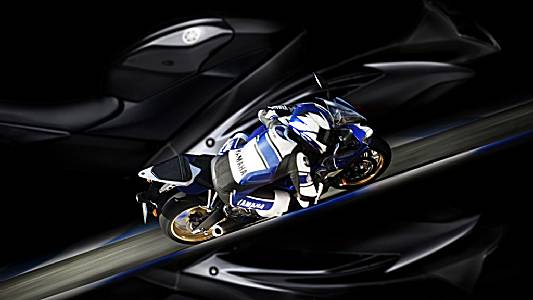
Advantages of the new 2008 Yamaha YZF-R6 engine:
- Adding an electronic intake geometry control system YCC-I (Yamaha Chip-Controlled Intake) - Yamaha's microprocessor intake control system.
- New pistons designed for engine with compression ratio 13.1 (compression ratio is 12.8 on the 2007 model).
- Changed settings for the YCC-T system and fuel injection system.
- Intake manifold new design.
- Improved connecting rod bearings and valve springs.
- Improved timing chain tensioner with hydraulic elements.
- 30% larger exhaust pipe diameter for increased torque.
- Reshaped rear section of the exhaust pipe.
Yamaha engineers and designers have not only optimized engine performance by making improvements to individual elements of the original design. Likewise, chassis performance has been improved through a series of minor but important improvements to many components.
The R6 development team completely changed the delicate balance of stiffness in the existing frame, making very slight changes to the wall thickness of the two frame beams, specifically in the rider's knee area. At the same time, the thickness of the steering column wall was increased, which provided increased rigidity. Also in the 2008 model year, the cross member between the right and left sides of the deltoid frame was removed. These minor changes, which are completely invisible from the outside, are designed to increase the rigidity of the steering column and, at the same time, slightly increase the level of longitudinal elasticity. The redesigned stiffness-to-strength ratio of the new frame results in better handling and more precise control when cornering at high speeds, enabling intense acceleration out of corners.
To match the revised handling characteristics of the new deltoid frame, the new, fully adjustable 41mm diameter fork features new inverted chainstays, which have also been re-stiffened. The stiffness of the aluminum lower triple yoke has also been tweaked to match the new fork stays and new frame features. This was achieved by increasing the width of the traverses and changing the shape of the ribs to reverse side traverse. In addition, the fork offset has been increased.
The 2008 Yamaha YZF-R6 also features a lightweight cast magnesium alloy subframe. This material was first used on Yamaha motorcycles for such a part. Magnesium has an exceptional strength-to-weight ratio, so the 450g weight reduction of the new subframe not only contributes to the reduction total mass motorcycle, but also helps to provide better mass distribution, which improves General characteristics manageability.
One of the essential elements that make a major contribution to the R6's exceptional responsiveness and stability is the long swing arm, pivoted close to the bike's midpoint to reduce squat during acceleration.
As with the new frame and fork upgrades, for 2008 the rigidity of this new swing arm has been modified by adding ribs inside the rear casting, while the end sections of the arm are now die forged from aluminum alloy rather than drawn.
On the 2008 Yamaha YZF-R6, the thickness of the 310mm dual front brake disc was increased from 4.5mm to 5.0mm. Not only does this improve heat dissipation performance under heavy brake use, but it also optimizes front wheel gyro moment, which improves front wheel stability and allows the rider to have a better “feel” for the front tire.
To reduce weight rear suspension the double-sided adjustable shock is mounted on a new lightweight bracket, similar to the one used on the latest R1 model.
On the Yamaha YZF-R6, 52.5% of the load is on the front wheel, so to optimize chassis performance, our design team has defined a rider position that further increases front wheel load when a person is on the motorcycle. The rider's hips are 5mm forward and the handlebars are 5mm forward and 5mm down. The angle of inclination down of the handles of the steering wheel has also undergone a change. These changes allow the rider of the R6 to have a closer and better feel to the front of the motorcycle, resulting in a more accurate perception of the motorcycle's interaction with the road. This allows the rider to select and accurately maintain the desired trajectory while turning faster and more accurately, which increases the pleasure and satisfaction of riding the motorcycle.
The third-generation Yamaha YZF-R6 raised the design bar with an aggressive, shortened body that gives the impression of a predator ready to spring for prey. While retaining the essence of the motorcycle's distinctive character, the body design of the new R6 for 2008 takes this concept to the extreme.
The feeling of movement forward and upward, created by an expressive line coming from rear wheel through the central axis and beyond, to steering column, saved. In the 2008 model, the upper edges of the side panels and the top plane were changed fuel tank, which emphasized the feeling of a forward mass and focused the center of vision on the front of the motorcycle.
The dynamic front fairing is also reshaped to give the bike an even more aerodynamic look, complemented by a new narrow 4-piece rear cowl. To reduce aerodynamic drag and to facilitate dismantling, the mirror brackets have been moved from the fairing surface to the fairing mounting brackets.
Technical features 2008 Yamaha YZF-R6 Chassis:
- Straight delta frame concept with steering column, swingarm rear suspension and rear axle that are in the same plane.
- Fully adjustable 41mm inverted fork, two compression damping adjustments.
- Fully adjustable rear suspension.
- Double front brake disc with a diameter of 310 mm with a radially located caliper.
Specifications motorcycle Yamaha YZF-R6 2008:
- Engine:
- Engine Type: Four-stroke, liquid-cooled, four-cylinder, in-line, forward-leaning, 16-valve, D0HC.
- Volume: 599 cm3.
- Bore and stroke: 67.0 x 42.5 mm.
- Compression ratio: 13.1:1.
- Maximum power: 94.9 kW (129 hp) at 14,500 rpm (without inertial supercharging) / 99.6 kW (135 hp) at 14,500 rpm (with inertial supercharging).
- Maximum torque: 65.8 Nm (6.71 kg/m) at 11,000 rpm (without inertial boost) / 69.1 Nm (7.05 kg/m) at 11,000 rpm (with inertial boost) .
- Lubrication system: Oil in crankcase.
- Carburetor: Injector.
- Clutch type: Multi-disc in oil bath.
- Ignition system: TCI.
- Starting system: Electric.
- Transmission system: Constant mesh, 6 gears.
- Drive type: Chain.
- Fuel tank capacity: 17.3 liters.
- Capacity oil system: 3.4 liters.
- Frame:
- Frame: Deltabox die-cast aluminum frame.
- Front suspension: Telescopic fork.
- Front suspension travel: 115 mm.
- Rear Suspension: Swingarm.
- Rear suspension travel: 120 mm.
- Front brake: Dual discs, ? 310 mm.
- Rear brake: Single disc, ? 220 mm.
- Front tire size: 120/70 ZR17M/C (58W).
- Rear tire size: 180/55 ZR17M/C (73W).
- dimensions:
- Length (mm): 2040mm
- Width (mm): 705mm
- Height (mm): 1100mm
- Seat height (mm): 850mm
- Wheelbase (mm): 1380mm
- Minimum ground clearance(mm): 130mm
- Dry weight (kg): 166 kg
In Russia, Yamaha YZF-R6 motorcycles will be officially offered in three possible colors: Yamaha Blue (Blue), Competition White (White), Graphite (Graphite gray).
Strictly speaking, the Yamaha R6 (YZF-R6) superbike, which belongs to the category of road motorcycles with an engine capacity of up to 600 cubic centimeters (Supersport 600 class), was originally a modification of the millennial Yamaha R1 (YZF-R1) in terms of frame design principles and overall design solution. But, to the credit of the design team, the further development of the sports version of the motorcycle went its own way. His appearance in 1998 at a presentation in Munich made a splash. The closest rivals in this class, the Honda CBR600, Suzuki GSX-R600 and Kawasaki ZX-6, could not compete. The flagship model of Yamaha R6 absorbed all the achievements of the creators of sports racing motorcycles and set a new level of standards for mass sports bikes.
Experts and specialists of the company divide the evolutionary development of a sportbike into six stages (generations), but this is not reflected in the designation of models in the form of additional letters or numbers. The company explains this by the fact that there are no cardinal changes in the development of the model, and generations are determined by the motorcycle production period. Exceptions are made for "named" series of bikes that fall into the public domain. For example, the YZF-R6S in 2009 or the YZF-R6 Limited (Rossi R46) in honor of Valentino Rossi (Italian: Valentino Rossi) - the unsurpassed rider of the Yamaha team.
Evolutionary path of development
Yamaha R6 (YZF-R6) first generation (1999…2000) received ( in brackets, for comparison, the best similar parameters of competitors are given):

- Inline 4-cylinder carbureted engine with water cooling and short-stroke piston group: cylinder Ø 67.0 mm, piston stroke 42.5 mm. An engine that developed 118 hp. (Honda CBR600 F3 - 105 hp) at a speed of 13 thousand rpm.
- Carburetor with electronic throttle control.
- Delta-shaped cast aluminum frame (the Honda CBR600 received an aluminum frame in 2005) with a long-link swingarm rear wheel suspension. The front wheel had the standard shock absorber suspension with brakes from the Thunderace model.
- shortened wheelbase- 1380 mm, which significantly improved handling in corners.
Much of what was incorporated in the first generation of the motorcycle is still used, which indicates a good design groundwork.
Second generation superbike (2001…2002) I “lost” 1.5 kg and received slight changes in color saturation, the square taillight was replaced with two round ones (stylized as rocket nozzles) and the size of the license plate mounting bracket was changed.
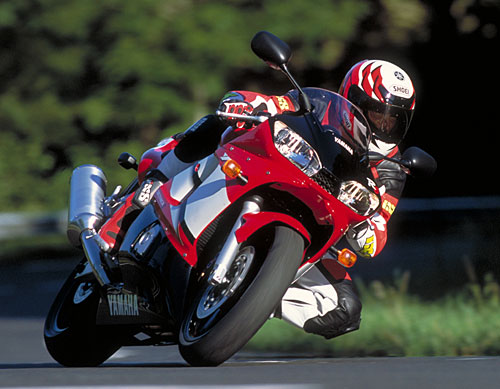
Technical changes affected:
- pistons and connecting rods, which are lightened for more stable idling;
- the angle of inclination of the clip-ons (steering wheel installation kit) has been changed to increase the comfort of the pilot;
- Engine work begins injection system power supply with inertial supercharging.
At the same time, the myth about the “voracity” of the Yamaha R6 in relation to oil (“at the level of gasoline”) was dispelled. The experience of many teams has shown that if you correctly run a run-in, and not “pull” new engine, then the oil consumption does not exceed the dimensions acceptable for machines of this class and purpose.
Yamaha third generation (2003…2004) became even "angrier and more aggressive." The changes in appearance were not dramatic - a headlight with 4 lenses, the shape of a gas tank and side plastic, the exterior became narrower and leaner, but they clearly separated the look of the new model from the previous ones.
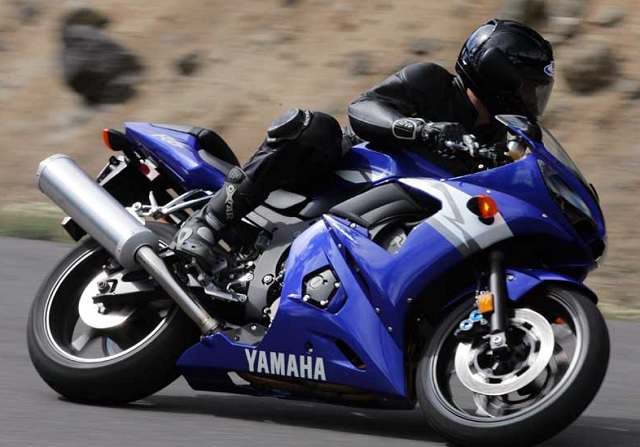
The third generation received new solutions in the technical part of the bike:
- the cast frame was replaced with a stamped one;
- stamped wheels with five spokes;
- a complete transition to an injector power circuit (a nozzle with 4 holes) with inertial supercharging was carried out, which “spun up” the engine to a power of 121.4 hp. at 13.0 ... 13.5 thousand revolutions.
Technical innovations have led to a weight reduction of up to 162 kg.
"Six hundred" sample 2005 year is the result of refinement of the previous generation. Motorcycle received:
- two fans per radiator;
- modification of the front fork of an inverted type;
- on the front wheel four-piston calipers with radial mounting;
- front brake discs increased to a diameter of 310 mm and became thicker by 0.5 mm;
- 10mm wider front wheel (120/70-ZR17) for improved handling
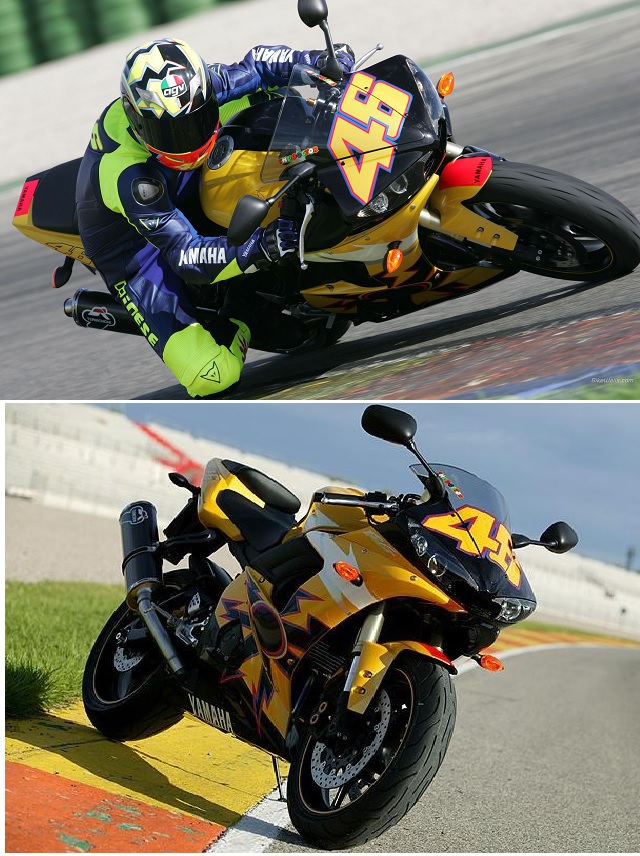
Due to the settings of the injection system, the mechanics managed to get a power of 124 hp. with a compression ratio of 12.4.
The fourth generation Yamaha R6 (2005) can be considered a stroke that completed the division of generations into a debut model or prototype (until the third generation) and a motorcycle that, in subsequent generations, was increasingly moving away from off-track use due to growing power, “aggressiveness” engine response and control acuity.
Fifth generation (2006…2007) It is characterized by the fact that all the novelties come from motorsport, which means that they are not focused on the average user. The bike is brand new:
- damper electronic control system (YCC-T);
- titanium valves;
- adjustable front fork with two levels of rigidity, depending on the "speed" of the track;
- slipper clutch;
- exhaust pipe with Exxir power valve;
- L-shaped rear pendulum suspension with attachment point;
- 124 hp engine, which easily “spins up” to 16.5 thousand revolutions per minute with a compression ratio of 12.8.

Improving the design of the engine has led to the complication of maintenance. Problems that are located “beyond the spark plugs” require the intervention of a minder with a set of specialized tools. The rumor that on a serviceable, but not warm enough engine, a sharp opening of the damper turns the crankshaft liners “on time” is not a myth at all. This is reality.
sixth generation(2008…2009)developed in the direction of improving the engine. Small changes in the form of a muffler extension, side plastic and gas tank shapes did not knock out of the YZF-R6 style. Technical innovations of the engine:
- installed electronic system geometry control of the YCC-I intake tract with a newly designed intake manifold (dynamically variable geometry), which changed the settings of the YCC-T system. The use of both systems and their fine tuning made the engine work more confidently at low and medium speeds and very efficient at speeds above 10 thousand;
- the working profile of the piston has been changed, which increased the compression ratio to 13.1. Changing the settings and compression ratio allowed the engine to develop 135 hp. already at 14.5 thousand rpm;
- new connecting rod bearings and valve spring material were used;
- the timing chain tensioner has been improved;
- Increased by 30% section of the exhaust tract.
Frame design changes are focused on increasing rigidity by changing the thickness of the frame elements, the handlebar mount and reducing weight (the magnesium subframe is 1.5 kg lighter than before). Chassis received improvements in the form of new stiffness settings for the front suspension and a redesign of the rear suspension swing arm.
seventh generation (2010… to present) did not bring any innovation. According to experts, the Yamaha R6 (YZF-R6) has reached the pinnacle of power, weight balance, handling sharpness and other racing characteristics.

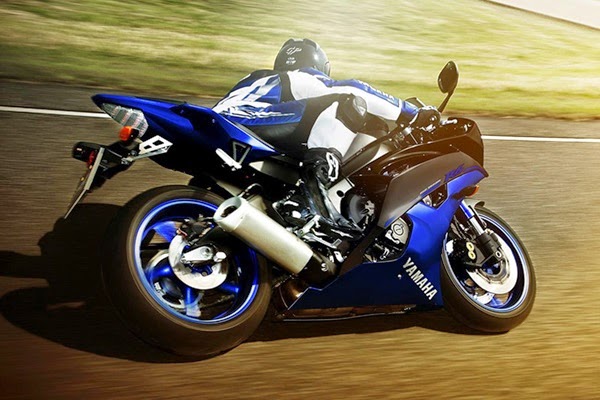
The new firmware of the control unit, the jewelry tuning of the YCC-T and YCC-I systems, the improvement in the shape of the air intake - only consolidate the achievements. On the appearance affected only increased in length by 10 cm exhaust pipe and new colors. Yamaha fans are looking forward to a repeat of 2003 or 2006, when the car left no chance for rivals, but the company is in no hurry to show its cards.
Hello Dear BikePosts!
From today I became a resident of this resource. Although I have been interested in its contents for a very long time and have been sitting here a lot of time. Thanks to this site, I learned a lot of useful things and other things ... I express my deep gratitude to all the residents for useful information!!! I am writing my first post, so do not judge strictly for grammar and stuff.
Since childhood, I have been crazy about motorcycles, I read a lot about them, I was interested ... My father had a Java 350, which he gave me for 18 years (because I didn’t ride it and it just stood - I completely moved to a car). Here on it I began to get the first experience, driving skills, etc. Surprisingly, there were no falls and everything went very well))) I really loved my motorcycle: it was always clean and serviceable - ready for any travel))) In total, I dashed off about 30 thousand km on it. And after that I had to sell the swallow (for family reasons). Later, the Viper Storm 150 scooter appeared - a pretty crazy Chinese. He also didn’t have a soul in him, but frequent breakdowns froze out (((And the father’s blackouts: supposedly put it on and don’t touch it and all that made me throw the keys on the table and not touch it, but during this time I wound about 20 thousand.
Being already in my 2nd year, I decided to earn money and buy that thread for myself, for everyday driving. Of course, I really wanted to buy a thread of a serious mot, but finances did not allow me to do this. And I scraped on a rickety Viper Active scooter. Having plucked up patience, I flew with the help of the first stepukha for spare parts on it. Let me tell you this is a great scooter! He has served me for a year and 10 t.km. At that time, I disappeared on our Ukrainian motorcycle forum, where I published the entire recovery process of my friend. For this year, I already packed it and sent it to rest) It's very cold ...
Everything changed dramatically after my friend introduced me to his friend who had a blue beauty Yamaha R1. I was drawn to Igor like a machine: I could talk about bikes with him for days, ride ... In a word, I fell in love with this bike. We talked for a long time, he corresponded, he even offered me a ride on it. But I refused, thinking that it’s too cool to sit down on a liter on the move, and God forbid I scratch it ... it will be kapets! But one day I gathered my thoughts and agreed to try:
I sat on it, listened to Igor's briefing and put on the helmet. For the first time I was in the outfit that day) My size coincided miraculously with Igor. He turned on the ignition and ran his eyes over the tachometer needle in both directions. I confess - the mot seemed to me not easy and I was very worried. All this took place on a steppe road not far away, there are no cars, the road is excellent. And then I turned on this beauty: it was strange this sound did not let me sleep later. Igor said that I should be careful ... I answered - this is a thrill !!! He told me to try spinning it to a cutoff, I confess - I have never felt this in my life. So the inclusion of 1st gear and start. Igor was very surprised how I coped with it as for the 1st time. Having driven back and forth several times, clapping the gears, I tried to turn and returned to him. It was unforgettable!!! It makes no sense to tell - who went knows! My experience with motorcycles and determination helped me a lot. Turns out it's not that hard.)
Later, I often asked Igorka to ride, embroidered around the city and even once dispersed it to 260. Then I didn’t turn off the gas, the car was really crazy)) Ride after ride, I fell more and more in love with this mot. My girlfriend was starting to get nervous =) I started thinking about buying a sport. But finances did not allow, and I began to plow like crazy with the thought: “I will not eat up, but I will collect money!”.
And then something happened, from which I just jumped to the ceiling - Igor was going to rush to work for the summer. He knew how anxious I was about his moth and he asked me to look after him))) It was something)
The summer of crazy rides has begun. Ezhzhu I carefully and I understand that the technique is not mine. Yes, and I realized that they trust me far from a moped. Unrealistically accustomed to the P1 all the time. My relatives practically didn’t see me at home, all the money went to fuel) I dashed off 6 pieces and didn’t have time to blink an eye - the summer came to an end. Igor returned and was stunned by the mileage passed))) As a token of gratitude, I gave him a new ass. tire, changed oil, spark plugs and chain with stars. I washed it and put everything in order) I am very grateful to this person for immersing me in this wonderful world))!
Here is actually my story) Since that moment I have set aside a pretty decent amount for me and I still earn money today. Day after day I think about how to buy a sport. I immediately rejected the option with a dockless and not cleared one (although I can already easily afford it). I plan to buy 600ku! Since the liter is a very powerful girl and we have nowhere to really reveal its potential, I don’t like handling for the village and the city, the consumption is also not small. I read a lot here about the Honda CBR600RR and Yamaha R6, I really liked these two bikes outwardly, I also considered the Ninja 6p. All the same, I decided to stop at Masha R6.
I want blue or black in 2005 good condition and with docks. We have them from 4000 USD to 7000 USD. I don’t want to be stupid with the choice, but ask experienced bikers about this bike: (if it’s not difficult for you, of course)
1. How much will a good p6 cost?
2. How is her handling in the city?
3. How much does he eat?
4. How much does it differ in agility from P1?
and it is very interesting to learn from you about this handsome man))) Thanks in advance to EVERYONE!
